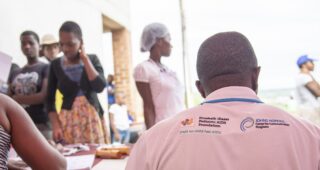HIV 101: Linking HIV and Vector-borne Diseases
You are here

Today (April 7), is World Health Day and this year, the World Health Organization (WHO) is raising awareness about vector-borne diseases such as malaria and neglected tropical diseases (NTDs).We are examining how these diseases and the efforts to combat them are linked to efforts to end HIV and AIDS worldwide.
Vector-borne diseases are spread by insects such as mosquitos, flies, ticks, bugs, and freshwater snails. These insects can spread diseases—like malaria, snail fever, and intestinal worm infections–that cause serious illness and death. Often, these diseases have the biggest impact on people living in resource-limited settings who don’t have access to treatment and prevention measures. More than half of the world’s population is at risk for vector-borne diseases and increased travel, trade, and migration make even more people vulnerable.
HIV cannot be transmitted via insects or other vectors—it can only be transmitted through direct contact with human bodily fluids such as blood, semen, and breast milk. It is commonly transmitted through sexual contact, intravenous drug use, or from a mother to her baby during pregnancy, child birth, or breastfeeding.
However, vector borne-illnesses can increase a person’s chance of contracting HIV and expedite the progression of the virus in people who are living with HIV.
Malaria
Both HIV/AIDS and malaria most commonly occur in sub-Saharan Africa and together cause more than 2 million deaths each year. Malaria is transmitted through a bite from female Anopheles mosquitos and can cause severe fever, body aches, seizures, and even death. Every year, more than 219 million people contract the disease, and in Africa, where 85 percent of the world’s malaria deaths occur, a child dies from malaria every 60 seconds.
HIV increases the risk of malaria infection, especially in children, pregnant women, and people with advanced HIV or AIDS as their immune systems are less able to fight infection. Pregnant women living with HIV who also become infected with malaria are at increased risk for anemia, placental malaria infection, and low birth weight. Malaria infection can also exacerbate HIV infection and potential transmission by causing higher levels of HIV in the blood of co-infected individuals. Drug treatments for both diseases also have to take into consideration potential drug-drug interactions that may lessen the effectiveness of the treatments.
Neglected Tropical Diseases (NTDs)
NTDs infect more than 1.4 billion people around the world and disproportionately impact women and children. Geographically, areas of high NTD infection overlap with areas that have high prevalence rates of HIV/AIDS.
Studies from the past 20 years have shown the different ways that HIV/AIDS can be exacerbated by various NTD co-infections. NTDs weaken the immune system, making it more likely for an individual to contract other diseases and less likely that they will be able to fight them. Pregnant women infected with intestinal worms, such as hookworm, roundworm, and whipworm, are also at an increased risk of transmitting HIV to their babies.
A parasitic infection known as schistosomiasis or snail fever is another major co-infection challenge that infects more than 200 million people, mostly in sub-Saharan Africa. It is transmitted by contact with contaminated fresh water–swimming, bathing, fishing, and even domestic chores such as laundry and herding livestock can put people at risk.
But one form of the disease has particular repercussions for women and their health and reproductive systems. Known as female genital schistosomiasis (FGS), it causes pain and bleeding in the uterus, cervix, and lower genital tract. These lesions provide conduits for the HIV virus to enter and infect women. Women with FGS are three to four times more likely to become infected with HIV. Not surprisingly, maps of the distribution of schistosomiasis and HIV in Africa reveal extensive overlap in southern Africa, especially in Mozambique, South Africa, Tanzania, and Zimbabwe.
Integration is Key
The good news is that by integrating treatment and prevention services for HIV with other diseases, like malaria and NTDs, we can help reduce the number of co-infections, work more efficiently, and build better lives for at-risk communities around the world.
Join us on Facebook and Twitter as we help spread the word about the important link between HIV and vector-borne illnesses and how only by working together can we create a future free of HIV!
Jeffrey Safrit, Ph.D. and Johanna Harvey
General



